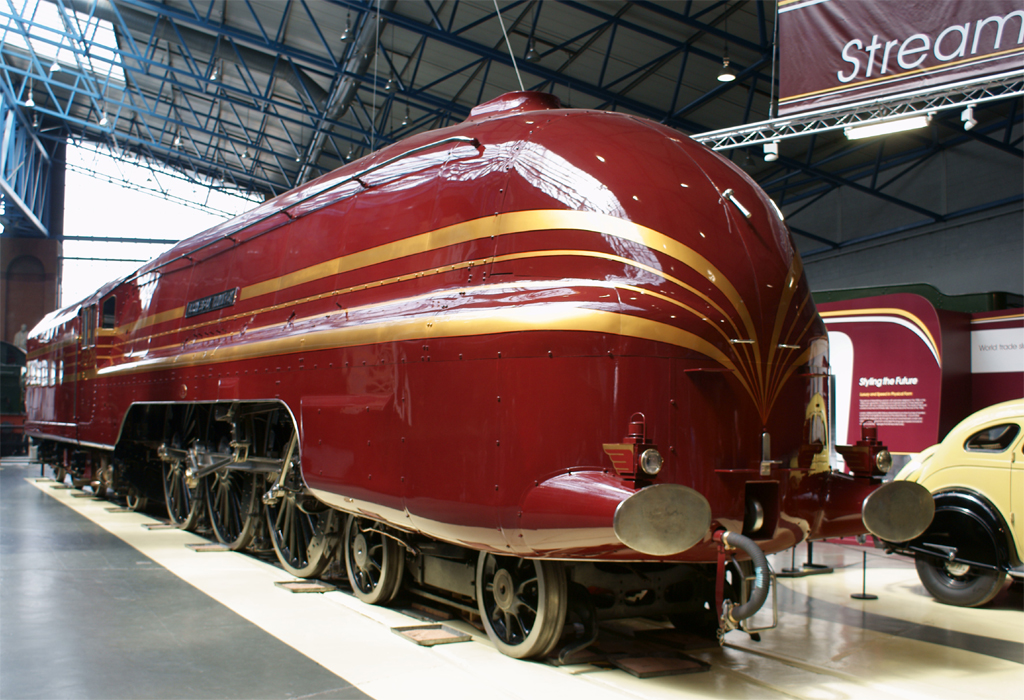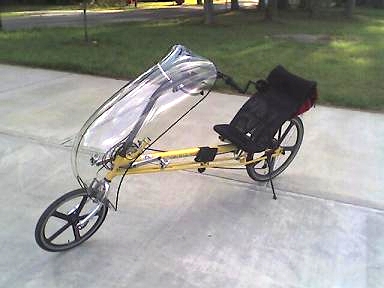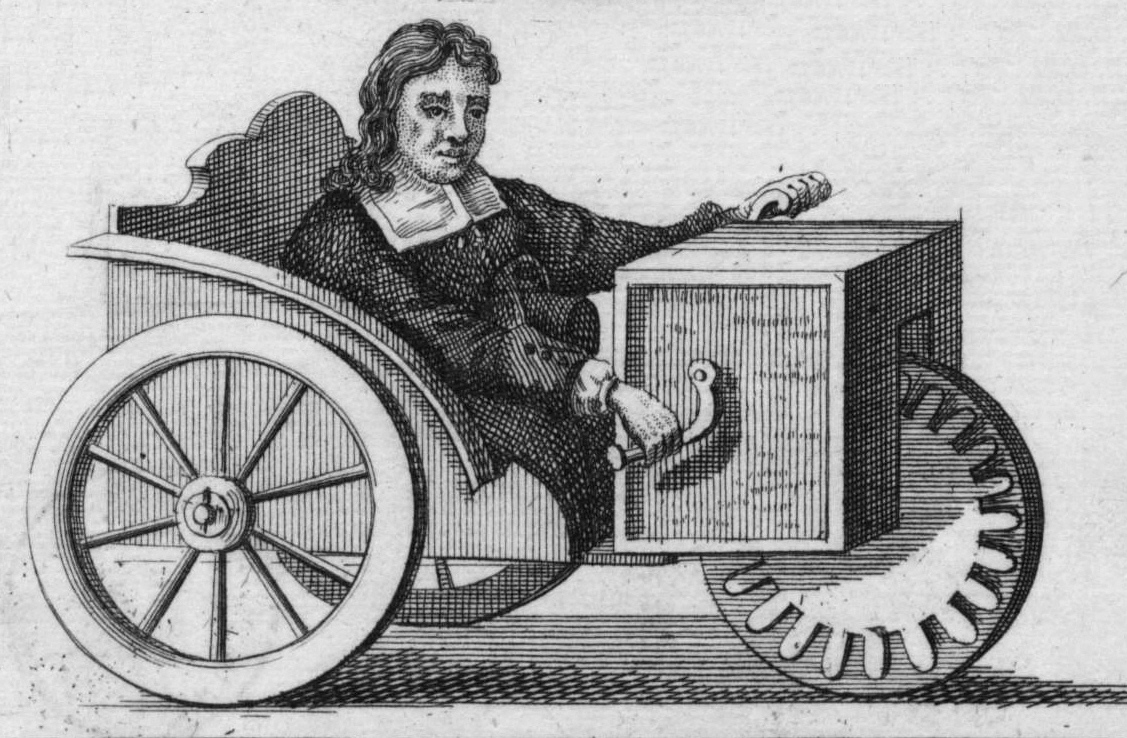|
Velomobile
A velomobile (); velomobiel, velo, or bicycle car is a human-powered vehicle (HPV) enclosed for aerodynamic advantage and/or protection from weather and collisions. Velomobiles are similar to recumbent bicycles, pedal go-karts and tricycles, but with a full fairing (aerodynamic or weather protective shell) and are not to be confused with purpose-built mobiles for racing or speed records fully faired vehicles with two wheels, generally called streamliners. Streamliners have set many speed and distance records. Though fast in their own right, velomobiles are considered much more suitable for the street than two-wheeled streamliners. Using three or more wheels can have advantages for everyday use, including the ability to stop and start unaided, better stability, cross-wind handling, etc., though there are arguments made that the multiple track machines (three or more wheels) have aerodynamic disadvantages due to the drag of the extra wheels and the surface contact points. In pra ... [...More Info...] [...Related Items...] OR: [Wikipedia] [Google] [Baidu] |
QuattroVelo
The Quatrevelo (formerly QuattroVelo) is a commercial-production velomobile which is notable for using both four wheels and also a highly aerodynamic fairing. The Quatrevelo is manufactured by in the Netherlands, with the first production models delivered in 2016. Features and comparison Velomobiles are a class of faired cycles. One "speed" class of velomobiles emphasizes fairing aerodynamics for high speed. Most velomobiles in this class use three wheels, and so it is instructive to compare the four-wheel Quatrevelo against three-wheel designs. "Speed" velomobiles (compared to "cargo" velomobiles) are limited mainly by aerodynamics and rolling drag. Thus, "low aerodynamic drag" has long been a focus for such designs. Three-wheel designs tend to have better aerodynamics than four-wheel designs: * Wheels are disks, and thus not very aerodynamic compared to a teardrop or other aerodynamic shapes. * There are significant aerodynamic losses where each wheel enters the fairing. * ... [...More Info...] [...Related Items...] OR: [Wikipedia] [Google] [Baidu] |
Leitra
Leitra is a Danish company and also the name of the velomobile it produces. In Sweden designs for a two-person, four-wheeled velomobile called the Fantom were sold as blueprints in the 1930s and 40s. Many thousands of sets of DIY instructions were sold, but very few vehicles were actually built. The body was made of plywood. The oil shock of 1978-9 inspired Carl Georg Rasmussen, a Danish engineer and pilot, to design and build the first practical velomobile. A tadpole recumbent tricycle A tricycle, sometimes abbreviated to trike, is a human-powered (or gasoline or electric motor powered or assisted, or gravity powered) three-wheeled vehicle. Some tricycles, such as cycle rickshaws (for passenger transport) and freight trikes ... with full glass-fiber fairing, it was dubbed the Leitra ('' Danish'': Let individuel transport, meaning "light individual transport"). About the company Carl Georg Rasmussen initially formed the company as a limited partnership with ten invest ... [...More Info...] [...Related Items...] OR: [Wikipedia] [Google] [Baidu] |
Velocar
Velocar was the name given to velomobiles made in the 1930s and 1940s by Mochet et Cie of Puteaux, France and colloquially to the company's recumbent bicycles. was the inventive maker of lightweight powered cyclecars (Le P'tit Auto) and pedal-powered cars (quadricycles), mainly two-seaters, built on a tubular-steel chassis with bicycle-sized wheels, variable gears, and aerodynamic bodywork, in effect a faired-in "sociable". The popularity of the little cars declined in the late 1930s as cheaper, powered cars became available, only to rise rapidly when petrol became almost unobtainable during World War II, 1939–1945. However, Mochet's stroke of genius was to make what was the first performance recumbent bicycle, or ''vélo couché'', using a design that was based on half of his four-wheeled Velocar. This machine, called by the factory the "Velo-Velocar", or "V-V" for short, broke many world cycling records in 1933. Although Mochet had verified with the UCI and the UVF that ... [...More Info...] [...Related Items...] OR: [Wikipedia] [Google] [Baidu] |
Streamliner
A streamliner is a vehicle incorporating streamlining in a shape providing reduced air resistance. The term is applied to high-speed railway trainsets of the 1930s to 1950s, and to their successor " bullet trains". Less commonly, the term is applied to fully faired upright and recumbent bicycles. As part of the Streamline Moderne trend, the term was applied to passenger cars, trucks, and other types of light-, medium-, or heavy-duty vehicles, but now vehicle streamlining is so prevalent that it is not an outstanding characteristic. In land speed racing, it is a term applied to the long, slender, custom built, high-speed vehicles with enclosed wheels. Trains Before World War II Europe The first high-speed streamliner in Germany was the " Schienenzeppelin", an experimental propeller driven single car, built in 1930. On 21 June 1931, the car set a speed record of on a run between Berlin and Hamburg. In 1932 the propeller was removed and a hydraulic system installe ... [...More Info...] [...Related Items...] OR: [Wikipedia] [Google] [Baidu] |
Bicycle Fairing
A bicycle fairing also called recumbent fairing is a full or partial covering for a bicycle to reduce aerodynamic drag or to protect the rider from the elements. It is more common to see recumbent bicycles with partial or full fairing. A bicycle with a full fairing is a regular bicycle fitted with an extra component, as opposed to a velomobile, which is a permanently enclosed bicycle. Bodysock Fairings are available for the front and rear of the vehicle. Some riders also use a "bodysock," a fabric (usually lycra) covering which connects the front fairing and the rear fairing, enclosing the rider for even less drag. Socks can also be run from a front fairing to an "A" shaped framework on the back of the seat. Or a "tailsock" can run from the back of the seat to the "A" shaped framework. A tailsock using lycra fabric and small aluminium tubes adds very little weight. Front and rear fairings have been shown to be beneficial for long wheelbase bikes, but front fairings are less bene ... [...More Info...] [...Related Items...] OR: [Wikipedia] [Google] [Baidu] |
Tricycle
A tricycle, sometimes abbreviated to trike, is a human-powered (or gasoline or electric motor powered or assisted, or gravity powered) three-wheeled vehicle. Some tricycles, such as cycle rickshaws (for passenger transport) and freight trikes, are used for commercial purposes, especially in the developing world, particularly Africa and Asia. In the West, adult-sized tricycles are used primarily for recreation, shopping, and exercise. Tricycles are favoured by children and senior adults for their apparent stability versus a bicycle; however a conventional trike has poor dynamic lateral stability, and the rider must take care when cornering to avoid tipping the trike over. Unconventional designs such as recumbents have a lower centre of gravity so require less care. History A three-wheeled wheelchair was built in 1655 or 1680 by a disabled German man, Stephan Farffler, who wanted to be able to maintain his mobility. A watch-maker, Farffler created a vehicle that was po ... [...More Info...] [...Related Items...] OR: [Wikipedia] [Google] [Baidu] |
People Powered Vehicle
The People Powered Vehicle, or PPV, was a two-person pedal-powered car introduced in the United States during the oil crisis of the early 1970s. Manufactured by EVI of Sterling Heights, Michigan, it sold for less than $400. Although it offered luggage space and was marketed as a fun and practical vehicle, it offered limited weather protection and was not fast enough to substitute for a car. The PPV may be considered a forerunner of the modern velomobile A velomobile (); velomobiel, velo, or bicycle car is a human-powered vehicle (HPV) enclosed for aerodynamic advantage and/or protection from weather and collisions. Velomobiles are similar to recumbent bicycles, pedal go-karts and tricycles, bu .... This tricycle was manufactured with a three-speed, floor shift, open type transmission with a single-wheel drive. Either the driver or the passenger could pedal independently or as a team. Reverse was accomplished by reaching outside and turning one of the rear wheels by hand. ... [...More Info...] [...Related Items...] OR: [Wikipedia] [Google] [Baidu] |
Recumbent Bicycle
A recumbent bicycle is a bicycle that places the rider in a laid-back reclining position. Most recumbent riders choose this type of design for ergonomic reasons: the rider's weight is distributed comfortably over a larger area, supported by back and buttocks. On a traditional upright bicycle, the body weight rests entirely on a small portion of the Tuberosity of the ischium, sitting bones, the feet, and the hands. Most recumbent models also have an aerodynamics, aerodynamic advantage; the reclined, legs-forward position of the rider's body presents a smaller frontal profile. A recumbent holds the world speed record for a bicycle, and they were banned from racing under the Union Cycliste Internationale (UCI) in 1934, and now race under the banner of the World Human Powered Vehicle Association (WHPVA) and International Human Powered Vehicle Association (IHPVA). Recumbents are available in a wide range of configurations, including: long to short wheelbase; large, small, or a mix ... [...More Info...] [...Related Items...] OR: [Wikipedia] [Google] [Baidu] |
Human-powered Vehicle
Human-powered transport is the transport of person(s) and/or goods using human muscle power. Unlike animal-powered transport, human-powered transport has existed since time immemorial in the form of walking, running and swimming. Modern technology has allowed machines to enhance human-power. Although motorization has increased speed and load capacity, many forms of human-powered transport remain popular for reasons of cost, convenience, leisure, physical exercise, and environmentalism. Human-powered transport is sometimes the only type available, especially in underdeveloped or inaccessible regions. Modes Non-vehicular * Crawling (human) * Walking (233 watts at 3 mph) ** Walking bus * Running (1,150 watts at 10 mph) *Sprinting (1,690 watts at 15 mph) * Swimming * Climbing and mountaineering * Ice skating, roller skating, and inline skating *Cross-country skiing Human-powered vehicles (HPVs) Land vehicles Skateboards have the advantage of being so small and ... [...More Info...] [...Related Items...] OR: [Wikipedia] [Google] [Baidu] |
Manufacturers
Manufacturing is the creation or production of goods with the help of equipment, labor, machines, tools, and chemical or biological processing or formulation. It is the essence of secondary sector of the economy. The term may refer to a range of human activity, from handicraft to high-tech, but it is most commonly applied to industrial design, in which raw materials from the primary sector are transformed into finished goods on a large scale. Such goods may be sold to other manufacturers for the production of other more complex products (such as aircraft, household appliances, furniture, sports equipment or automobiles), or distributed via the tertiary industry to end users and consumers (usually through wholesalers, who in turn sell to retailers, who then sell them to individual customers). Manufacturing engineering is the field of engineering that designs and optimizes the manufacturing process, or the steps through which raw materials are transformed into a final produ ... [...More Info...] [...Related Items...] OR: [Wikipedia] [Google] [Baidu] |
Bottom Bracket
The bottom bracket on a bicycle connects the crankset (chainset) to the bicycle and allows the crankset to rotate freely. It contains a spindle to which the crankset attaches, and the bearings that allow the spindle and crankset to rotate. The chainrings and pedals attach to the cranks. Bottom bracket bearings fit inside the bottom bracket shell, which connects the seat tube, down tube and chain stays as part of the bicycle frame. The term "bracket" refers to the tube fittings that are used to hold frame tubes together in lugged steel frames which also form the shell that contains the spindle and bearings; the term is now used for all frames, bracketed or not. There is some disagreement as to whether the word ''axle'' or ''spindle'' should be used in particular contexts. The distinction is based on whether the unit is stationary, as in a hub, or rotates, as in a bottom bracket. American bicycle mechanic and author Sheldon Brown uses ''axle'' once and ''spindle'' four tim ... [...More Info...] [...Related Items...] OR: [Wikipedia] [Google] [Baidu] |
Crankset
The crankset (in the US) or chainset (in the UK), is the component of a bicycle drivetrain that converts the reciprocating motion of the rider's legs into rotational motion used to drive the chain or belt, which in turn drives the rear wheel. It consists of one or more sprockets, also called ''chainrings'' or ''chainwheels'' attached to the '' cranks'', ''arms'', or ''crankarms'' to which the pedals attach. It is connected to the rider by the pedals, to the bicycle frame by the bottom bracket, and to the rear sprocket, cassette or freewheel via the chain. Parts Cranks The two ''cranks'', one on each side and usually mounted 180° apart, connect the bottom bracket axle to the pedals. Lengths Bicycle cranks can vary in length to accommodate different sized riders and different types of cycling. Crank length is measured from the center of the pedal spindle to the center of the bottom bracket spindle or axle. The larger bicycle component manufacturers typically offe ... [...More Info...] [...Related Items...] OR: [Wikipedia] [Google] [Baidu] |





